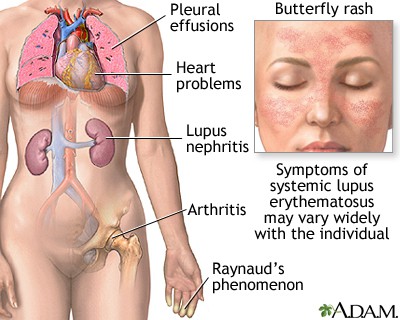Systemic lupus erythematosus (SLE), often referred to simply as “lupus,” is an uncommon multi-faceted disorder that can affect almost every organ in the body. In the UK it affects around 1 in 10000 people with women, especially those of child-bearing age, being nine times more susceptible than men.
Incidence of the disease in different countries varies according to ethnic make up: the condition being more common in Afro-Caribbeans and Asians. There is also a familial relationship: those with family members affected are at increased risk of contracting the illness.
Incidentally, the name lupus comes from the Latin “wolf.” It was thought in past times that the skin lesions which sometimes manifest in this disease resembled wolf bites.
Pathology of Lupus

The precise nature of the disease processes behind lupus is unknown but it’s thought to be an autoimmune reaction. For some reason the immune system starts to produce antibodies to DNA, the subsequent antibody – DNA reaction brings about severe damage to the cells involved. It’s been suggested that the autoimmune reaction may be triggered by a virus.
Lupus manifests in the body’s connective tissues. Connective tissue forms the scaffolding of all organs and vessels and as such is universal in the body. This is the reason that lupus can affect every organ in the body although it doesn’t always do so, most sufferers will have certain organs spared.
Clinical Features of Lupus
As might be expected, these are very varied and depend on which tissues or organs are affected. And as many of the signs and symptoms of lupus are the same as occur in other related disorders such as rheumatoid arthritis, it can be difficult to obtain an accurate diagnosis from physical signs alone. Laboratory tests are usually required to pin down the diagnosis.
The severity of signs and symptoms is also very variable but generally made worse by infection or pregnancy.

Below is a list of the organs and tissues affected together with their features.
- Musculoskeletal: The commonest complaints are pains in muscles and joints. Sometimes more severe with joint swelling and tendon contractures.
- Skin: The classic presentation is a ‘butterfly’ rash across the nose and cheeks. The scalp can be affected, leading to reversible hair loss. Rashes frequently become worse on exposure to sunlight.
- Systemic: Tiredness and fatigue are common as are bouts of fever.
- Neurological: Seizures, headaches, tremors and depression are fairly common.
- Kidney: hypertension and ureamia (high blood urea levels)
- Lungs: pleurisy and pneumonia.
- Cardiovascular: inflammation of the heart muscle and inner lining of the blood vessels.
Management of Lupus

In mild cases where the main features are musculoskeletal, non-steroidal anti-inflammatory drugs are given, steroids if the patient is unresponsive to these. Antimalarial drugs are also given for joint and muscle problems as well as for fatigue and rashes. Immuno-suppressant drugs such as methotrexate are used in severe cases.
Prognosis for Lupus
It should be remembered that very few people develop all the manifestations of lupus, in many cases the disease stays at a low level most of the time with occasional flares. In recent years the management of the condition and its organ effects has improved enormously.
This article is for information only. If you have any health concerns you should consult your doctor.


















